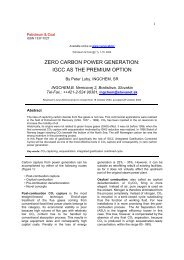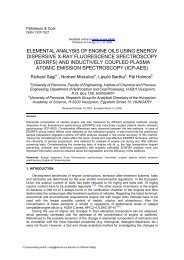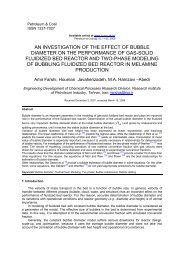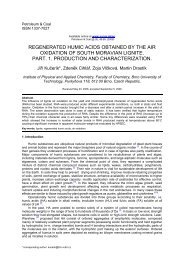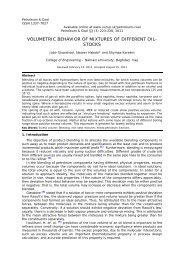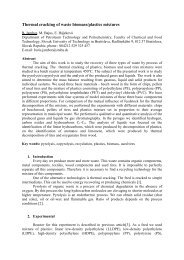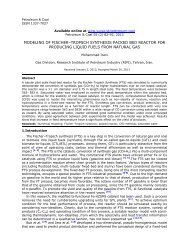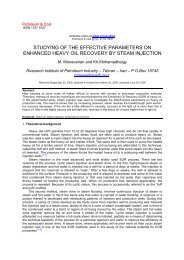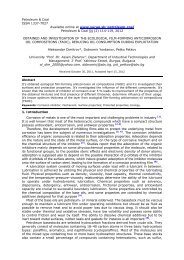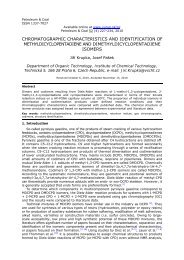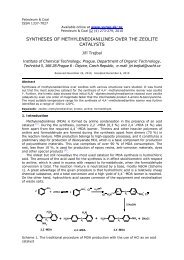reliability assessment of offshore jacket structures in niger delta
reliability assessment of offshore jacket structures in niger delta
reliability assessment of offshore jacket structures in niger delta
You also want an ePaper? Increase the reach of your titles
YUMPU automatically turns print PDFs into web optimized ePapers that Google loves.
eliability <strong>of</strong> the group brac<strong>in</strong>gs was estimated and presented <strong>in</strong> Table 2. The completebrac<strong>in</strong>g member <strong>reliability</strong> and <strong>jacket</strong> legs <strong>reliability</strong> were also established <strong>in</strong> Table 3 and4 respectively. The overall <strong>reliability</strong> <strong>of</strong> the <strong>jacket</strong> structural systems and <strong>reliability</strong> factorwere also estimated and presented <strong>in</strong> Table-5.The data gathered dur<strong>in</strong>g the platform survey <strong>in</strong>cludes anodes percentage utilization.The survey revealed that anodes located <strong>in</strong> the splash zone are depleted faster than the oneplaced <strong>in</strong> the other tidal zones along the <strong>jacket</strong> length. A <strong>jacket</strong> structural member wasflooded due to pitt<strong>in</strong>g corrosion <strong>in</strong> the jo<strong>in</strong>t welds.The entire <strong>jacket</strong> was found to be covered with uniform rust<strong>in</strong>g. The member corrosionlosses range from 0% to 17% compared with members as built thickness. The rate <strong>of</strong>corrosion is found to be higher <strong>in</strong> the splash zone than any other tidal zones due toaccelerated corrosion process <strong>in</strong> the area.In this paper, the failure mode <strong>of</strong> <strong>jacket</strong> <strong>structures</strong> was <strong>in</strong>terpreted as either series orparallel systems and depends on member arrangement and correlation. The brac<strong>in</strong>g membersare <strong>in</strong> parallel systems failure mode and majority <strong>of</strong> brac<strong>in</strong>gs yield for failure before thestructure collapse mode is wholly developed. The failure mode <strong>of</strong> a <strong>jacket</strong> platform legs isassociated with series system and if any one <strong>of</strong> the legs develop failures mode the wholeplatform is considered to has failed and recommended for abandonment.The <strong>reliability</strong> <strong>assessment</strong> method developed <strong>in</strong> this study is most appropriate s<strong>in</strong>cethe technique elim<strong>in</strong>ate the rigorous exercises associated us<strong>in</strong>g 3D computer s<strong>of</strong>tware forexist<strong>in</strong>g platform <strong>assessment</strong> due to member corrosion losses. The method is a handy tool tomonitor structural safety with regards to structural member thickness corrosion loss andit can be accomplished with pocket calculator or Micros<strong>of</strong>t excel-s<strong>of</strong>tware. ReliabilityFactor (FR) is proposed <strong>in</strong> the study to establish <strong>jacket</strong> <strong>structures</strong> safety as the platformis age<strong>in</strong>g.3.1 Reliability FactorThe <strong>reliability</strong> <strong>of</strong> a newly <strong>in</strong>stalled <strong>jacket</strong> is 1 or 100%, s<strong>in</strong>ce the structural membersare corrosion free. A factor (RF) is hereby established between an <strong>in</strong>tact and corroded<strong>jacket</strong> structural system <strong>reliability</strong> to determ<strong>in</strong><strong>in</strong>g the rate <strong>of</strong> structural system <strong>reliability</strong>decreases.The proposed factor can be represented mathematically as:1RF = (17)R nM.A. Salau, D.E. Esezobor, M. F. Omotoso/Petroleum & Coal 53 (4) 291-301, 2011 297R n – Jacket structural system <strong>reliability</strong>Accord<strong>in</strong>gly, <strong>jacket</strong> <strong>reliability</strong> prediction for the year 2008 is estimated and presented<strong>in</strong> Table 5. The factor is essential to determ<strong>in</strong>e <strong>jacket</strong> safety dur<strong>in</strong>g the operat<strong>in</strong>g lifecycleas the factor shows <strong>jacket</strong> <strong>reliability</strong> reduction rates. The value is suggested to be 1.0 to1.25 s<strong>in</strong>ce load factor <strong>of</strong> safety is about 1.25 depend<strong>in</strong>g on the load under consideration.However, this factor may be fixed by <strong>in</strong>dividual operator <strong>of</strong> the platforms based on herbest eng<strong>in</strong>eer<strong>in</strong>g practice.Table 5 System Reliability & Reliability Factor EstimationS/N Period 1985 20081 Duration 0 yrs 23 yrs2 Support Legs (R SL ) 1 0.99953 Jacket Brac<strong>in</strong>g (R SG ) 1 0.85784 Reliability (R SJ ) (1.0 x1.0) =1.0 (0.9995 x 0.8578) = 0.85775 Reliability Factor (RF) (1.0/1.0) =1.0 (1.0/0.8577) = 1.1664. ConclusionsTime-variant formulation for <strong>reliability</strong> <strong>assessment</strong> <strong>of</strong> an exist<strong>in</strong>g <strong>of</strong>fshore <strong>jacket</strong><strong>structures</strong> was derived and presented taken <strong>in</strong>to account structural component damage dueto corrosion loss. Application <strong>of</strong> series and parallel <strong>reliability</strong> theories was applied for theestimation <strong>of</strong> <strong>jacket</strong> structural system <strong>reliability</strong>, with regards to member corrosion wastage.The technique was proposed for <strong>of</strong>fshore <strong>jacket</strong> structural <strong>assessment</strong> procedures.The advantage <strong>of</strong> this <strong>assessment</strong> method over manual structural member capacitycheck and 3D computer model due to corrosion loss <strong>in</strong>cludes provision <strong>of</strong> structural <strong>reliability</strong>values for <strong>in</strong>dividual member and as well as for the whole <strong>jacket</strong> structural system. This



